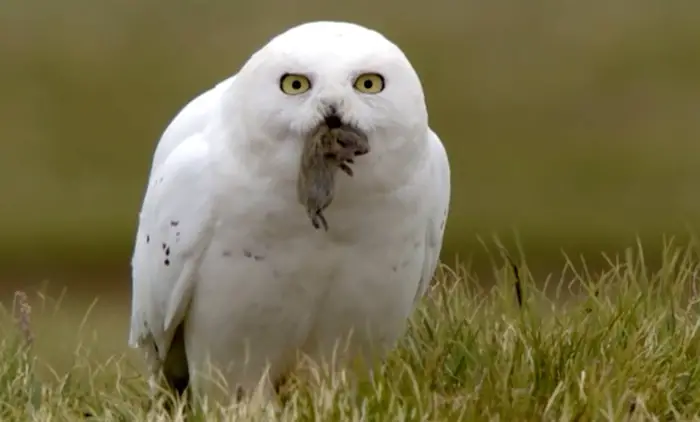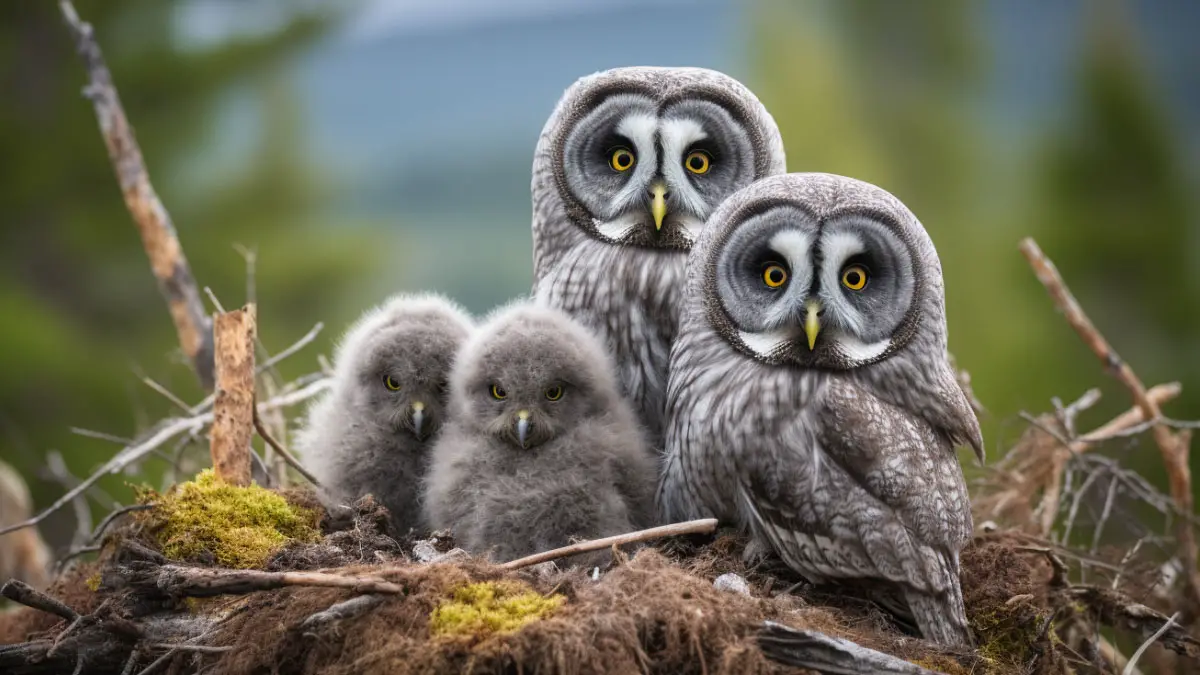Snowy Owls (Bubo scandiacus) are well-known for their distinctive appearance. These large owls are distinguished by their snowy white feathers, which provide excellent camouflage in their Arctic habitat. These magnificent birds of prey have a diet that is as intriguing as their snowy white plumage.
So, what is the Snowy owl’s diet? Snowy Owls are carnivorous and primarily eat lemmings when they are abundant in the Arctic tundra. When lemming populations are low, they adapt their diet to include small mammals like voles and hares, as well as birds such as waterfowl and even fish in coastal areas.
This article will expound more on the Snowy Owls’ diet. We will discuss what these birds eat in the wild and how they manage to thrive in some of the harshest environments on Earth.
What Do Snowy Owls Eat?
Snowy Owls are carnivorous predators that only eat other animals. Their predatory nature is evident in their sharp beaks and powerful talons, which they use with precision to capture and consume their prey. These avian predators are also opportunistic hunters.

They have an amazing ability to adjust their diet in response to environmental conditions. The diversity of their diet is influenced by factors such as geographical location, seasonal variations, and the availability of suitable prey.
That said, let’s take a closer look at the various types of prey that Snowy Owls commonly target in their natural habitat.
1. Lemmings
The lemming is a small burrowing rodent abundant in the Arctic tundra. Snowy Owls primarily feed on lemmings when lemming populations are high. It is not uncommon for these owls to consume multiple lemmings in a single day. This reliance on lemmings can cause dramatic fluctuations in their diet from year to year, mirroring the cyclical nature of lemming populations.
2. Small Mammals
In addition to lemmings, Snowy Owls opportunistically target other various small mammals. During late November and early December, Snowy Owls commence their southward migration, an event known as an “irruption.”
Their diet undergoes a transition, with a shift towards hunting other small mammals such as squirrels, voles, squirrels, rabbits, and mice. This adaptability allows them to thrive in their temporary habitats during the winter months.
Also, Snowy Owls have a strong preference for Northern Canada during the summer months. In this vast, treeless expanse, vegetation is limited to dwarf shrubs and sedges, and only a few species can withstand the harsh conditions.
Arctic hares, chinchillas, marmots, pikas, and arctic ground squirrels are among the hardy mammals that have adapted to this environment. Because they are a readily available source of food during the summer, these small rodents become prime targets for the Snowy Owl.
3. Birds
Snowy Owls are skilled avian hunters capable of capturing various bird species. Their prey includes smaller songbirds, waterfowl, ptarmigans, grebes, gulls, ducks, geese, pheasants, grouse, and coots. Snowy Owls also occasionally target other owl species, such as the smaller short-eared owl.

This distinctive behavior typically occurs in the latter stages of the breeding season when the availability of lemmings dwindles. The Snowy Owls must select prey that offers a more efficient and energy-conserving hunting opportunity.
Snowy owls will also consume the young and eggs of small owls, which are often easier to access than pursuing flying game birds like grouse.
4. Fish
While less common in their diet compared to mammals and birds, Snowy Owls in coastal regions have been known to include fish in their menu.
Their keen eyesight aids them in spotting fish near the water’s surface, and they employ their talons to snatch them from their aquatic domain.
5. Other Prey
Snowy Owls also eat insects, carrion (the flesh of dead animals), and even occasional crustaceans.
How Do Snowy Owls Hunt?
To capture their varied prey, Snowy Owls employ a combination of hunting techniques and physical adaptations. They include the following.

Stealthy Approach
One of the key elements of Snowy Owls’ hunting strategy is their ability to approach their prey stealthily. Their snowy white plumage provides exceptional camouflage against the icy landscape of the Arctic tundra.
They scan their surroundings for potential prey while perched on elevated vantage points such as rocks or small hills. When they spot a target, they move with deliberate caution to get closer to their prey.
Powerful Talons
Snowy Owls have strong talons for gripping and piercing. When Snowy Owls approach their prey, they use their talons to quickly seize and immobilize the target. This limits their prey’s ability to flee.
Incredible Vision
Notably, one of the unique features of a Snowy Owl is that it is diurnal, meaning they are active during the day. This diurnal behavior complements their incredible vision.
Snowy Owls have large, bright yellow eyes that are highly sensitive to light and motion. This provides them with an unparalleled advantage in spotting potential prey from considerable distances. This acute vision is particularly valuable when hunting in the open tundra landscape.
How Much Do Snowy Owls Eat?
The dietary requirements of Snowy Owls vary depending on factors such as age, reproductive status, and the availability of prey. Typically, throughout the year, a single Snowy Owl can devour more than 1600 of its preferred rodents, the lemmings.
Their typical daily intake ranges from three to five lemmings. Notably, Snowy Owls can store fat during times of abundance. This adaptation serves them well during times of lemming scarcity, as they can survive for up to 40 days without the need for fresh food.

During the breeding season, when Snowy Owls are raising their chicks, their energy requirements are significantly higher. They significantly increase their food consumption to support the growth and development of their offspring. The Snowy owl can eat 8 – 12 lemmings in a single day.
This period frequently coincides with the availability of lemmings and other small mammals in the Arctic tundra. This serves as an important food source for both adults and chicks.
The size of Snowy Owl prey also influences how much they eat. When hunting smaller prey, such as lemmings or small rodents, they may need to consume several individuals in a single hunting session to meet their energy needs.
Larger prey, such as waterfowl, provide a substantial meal, reducing the frequency of hunting.
Conservation Efforts
Snowy Owl conservation initiatives frequently include the preservation and protection of their Arctic habitats. One of the most pressing issues in Snowy Owl conservation is the impact of climate change on their diet and habitat.
As global temperatures rise, the Arctic will experience rapid changes, including shifts in prey availability. Snowy Owls’ primary food source, lemmings, is extremely sensitive to climate change. Warming temperatures can disrupt lemming populations, causing fluctuations in their availability.

As a result, Snowy Owls may have difficulty finding adequate food resources during breeding seasons, which can have a negative impact on their reproductive success.
Scientists and conservationists conduct research to monitor Snowy Owl populations and study their dietary habits in order to better understand their specific needs.
Efforts also extend to raising awareness about the importance of preserving Snowy Owl habitats and the broader Arctic ecosystem. Collaborative projects engage local communities, researchers, and governments to ensure the long-term well-being of these magnificent birds.
FAQs
Let’s address some common queries about the Snowy Owls’ diet.
Baby Snowy Owls rely on regurgitated food provided by their parents. This primarily consists of small mammals like lemmings and other rodents. As they develop and gain strength, their diet gradually transitions to whole prey items, including small mammals and, eventually, birds.
While Snowy Owls are formidable predators, they are not immune to predation themselves. Several larger predators may target Snowy Owls. These potential predators include Arctic foxes, wolves, and sometimes even larger raptors like the Peregrine Falcon.
After capturing their prey with their powerful talons, they use their sharp beaks to tear the prey into smaller, manageable pieces. These pieces are then swallowed whole. Snowy Owls lack the ability to chew their food, so their digestive system processes the food and breaks it down. Indigestible parts, such as bones and fur, are regurgitated as pellets.
Conclusion
Snowy Owls are formidable and adaptable predators in the vast, frozen expanses of the Arctic tundra. They eat lemmings as their main source of food, but they also eat other small mammals, birds, and even fish.
They are incredibly adaptable in their search for food. Their hunting techniques, marked by stealth, powerful talons, and acute vision, demonstrate their expertise as hunters.
Snowy Owls, on the other hand, face challenges such as climate change, which alters the dynamics of their habitat and food sources. Conservation efforts are critical to preserving these magnificent birds and the fragile ecosystems in which they live.







